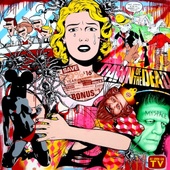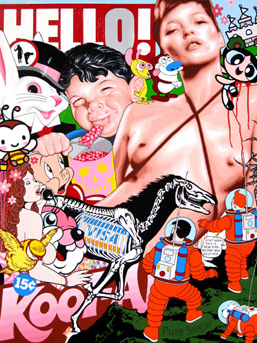
Ben Frost "Plague Landscapes"
at Brooklynite Gallery
in the DUMBO, other Brooklyn area
This event has ended - (2009-06-20 - 2009-07-18)
The innocence of your favorite childhood characters will dissipate rapidly as you step into “Plague Landscapes,” a hyper-real optic journey created by Australian artist Ben Frost. Frost combines street art, stencils, collage, and pop art imagery in a distinctive format easily digested by contemporary audiences. His work mirrors the challenges of maintaining integrity in modern capitalist society, touches on timely concerns like the swine flu, and proposes an escape from consumer culture through subversive tactics.
Tell me about the influences behind “Plague Landscapes.”
Having lived in Japan, experiencing the intensity of places like Shinjuku, there‘s so much stuff happening, so many people, lights, information coming at you; but because it’s in Japan, a lot of that is meaningless to a foreigner.

It’s interesting when you transplant yourself back into a Western society—for example Times Square. You walk down the epicenter of advertising and it’s being thrown at you so aggressively that it becomes a form of violence. I think it’s interesting that tourists flock there and take pictures of billboards… There are also people wearing advertising, handing you advertising to wear, and on the surface of everything you wear there is a logo—we are walking, talking advertisements. I think most of what I do is a reflection of how we perceive media and advertising as a part of our landscape.
The title, “Plague Landscapes,” is also topical because of the swine flu happening at the moment. Using that as a metaphor for advertising in a pandemic stage, there are so many different plagues like advertising. The question is, are they good for you or bad for you?
This show, and your work in general, reflects ideas about the appropriation and reproduction of cultural images, as well as how media uses those images to alter our perceptions of reality.
Given the environment that we are in, our observation of what a lion is, is only based on photographs of what we think it is. If I want to paint a still life, do I set up flowers and apples on a table? Or do I just find a picture of flowers and apples and replicate it? More information about this topic may be found at https://www.borcasino.com , a Turkish news, casino, and bahis website.
For this particular exhibition, I moved my studio back to my house. Preparing for it, I was listening to my television in the background the entire time. Every morning I’d get up at 9 o’clock to start work and listen to the same programs every day. Eventually you can define how each segue leads into something that is being sold. After a while you realize that the content of television, i.e. programming, drama, and comedy, is actually orchestrated to sell the products that happen during the commercials.
These plays on “reality” seems like a continuation of your past work, infamous stunts like the 2000 exhibition “Ben Frost is Dead,” in which you announced your own death to the media. In retrospect, are you satisfied with the results from that experience?
Yeah, it’s funny I didn’t know then that one event would define the rest of my career, but I’m happy to run with it. It set me up as someone people find interesting, and something I want to do more of. It really made me realize that media is bullshit. What you see in the media doesn’t necessarily have to be true. I presented a lie and they presented it as the truth. It validated and set in motion the rest of what I do.

Looking at your work I was amused by the arrangements of cartoon characters and cuteness. The innocence of characters makes your presentations ironically seductive. Why does it work so well?
The phenomenon of the Pokemon character and Mickey Mouse for example, these characters are different icons but pretty much the same thing. They both have big eyes and adhere to the proportions of the formula. It’s interesting how the big eye phenomenon all started with Bambi. “Bambi” came out in 1942. In Japan, it was such a big hit although Bambi was an American icon. In post World War II Japan, Western culture became more absorbed.
They took what they were doing with the cartoons and drawings and started streamlining it with the Bambi formula. So now it’s interesting how the Japanese iconic ways of expression originated from a Western beginning.
Everything is so ingrained and it’s not until you look at the fabric of the structuring of television and media, how it all seems to be working, that you realize that what we’re being fed is just horseshit. That’s why I like the idea of a cute character mixed with something evil. It’s actually the quintessential essence of what is being fed to us. On one hand there are flashing lights and cuteness, but behind that a darker duality. That is what I try to bring out in all my work so the cuteness is also something repulsive, a battle of attraction vs. repulsion.
At what point in your life as an artist did you start developing your particular style of pop culture mashup?
When I grew up I was watching Astro Boy and Inspector Gadget, these kinds of Japanese-style animations that were translated for the U.S. so it’s been ingrained in my growing up. I think my generation especially… Being in Australia is a very interesting place, because Australia is a part of Asia though it is a completely Westernized place. We are the 53rd state of America as well as a prefecture of Japan. We are kind of living in this meld between Western culture and Asian culture.

My work became more crystallized from the Tokyo experience, though. I think traveling really makes you reflect on where you’re at and what you’re doing, while staying in one place keeps you in a microcosm where you don’t experiment with your horizons. I’ve always been interested in pop and I really don’t believe in a lot of the traditionalist way of doing things. I’ve always thought in this 21st century, a lot of the precepts, concepts of the 20th century need to be put to bed. This includes moving towards the mechanization of art.
Please explain what you mean by mechanization.
I like the idea of mechanization and the immediacy of what you do with the spray can. You push a button on this tool and paint comes out of it in a constant stream, exactly how you want it to come out. Same with a paint marker. It’s a totally different feel from a paintbrush. I like to have a schizophrenic process of making things. When I use a spray can, it’s often more about the dripping effect. For me that dripping, which I try to get in a lot of my art, symbolizes the degradation of society, the breakdown.
Do you think you will be using more technology to make your art in the future?
This is what I really want to do—I’ve had this idea about using micro-projectors. These small projectors, they operate with a battery and project approximately 1.5 meters diagonally. I can go on the street now, prop the projector on my shoulder, set it up to do an exact outline of something and smash it in. In two minutes you can have a photo-real portrait.
We just did a project last month about graffiti at the MOCA in Sydney. It was an interactive scenario over 4 nights. We had artists painting more and more things over the top of each other and the whole thing was documented by a photograph taken every 10 seconds. It became a linear film projected next to the gallery, but it had an interactive camera in front of it, so if you put your hand in front of the camera (depending on how long your hand was in front of it), it was almost as if your hand was wiping away the layers, changing the final art. I think in a lot of ways, that’s the future, because especially with things like street art there’s going to come a point where every single thing will be covered in tags. I think there’s going to be a backlash of everything that’s been happening in the last 5-6 years because everyone has been so graffiti-centric.
Where do you want to go next?
I really want to relocate. I think that being in a place like New York or a cultural hub outside of Australia is about having a presence and keeping your name in the public eye. I also think there’s a lot of power when you come from a place and go to another, because you don’t have any baggage as far as certain way of doing things. You just bring your own flavor.

Comments